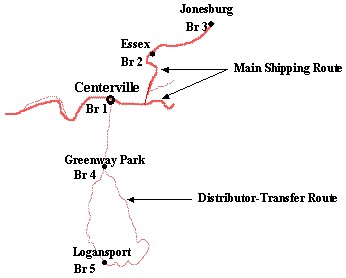
In a central warehousing scheme, your vendor plays a key role in how products get delivered to your child branches. Drop points are based on rules for the vendor that indicate which branch gets which products delivered. To set up and define drop points, use Drop Points Maintenance. You can override a drop point on a purchase order, if needed. Also, when using drop points, be aware of the order entry restrictions.
For example:
Your company has five branches: the parent branch (1) and four child branches (2-5). The vendor agrees to deliver products to the parent branch and branches 2 and 3 because they are along the shipping route. It is your responsibility to get the products to branches 4 and 5. So, you set up branches as drop points for branch 1.
If your branches are set up as shown in the map below, then the vendor places items for branch 4 and 5 on separate pallets and branch 1 receives both branch 4's pallets and branch 5's pallets.

Order entry restricts points in the following ways:
If a generation is cancelled and the receiving branch for that generation is defined as a drop point for the P/O, the cancellation completes after the receiving branch is removed as a drop point for the purchase order.
If sales personnel attempt to change the receiving branch from the Scheduling screen and that receiving branch is defined as a drop point for the order, then the change commits after the original receiving branch is removed as a drop point for the order.
If sales personnel attempt to delete a line item for a branch defined as a drop point and this is the last item on the generation, a warning displays indicating you must delete the drop point to continue.
See Also: